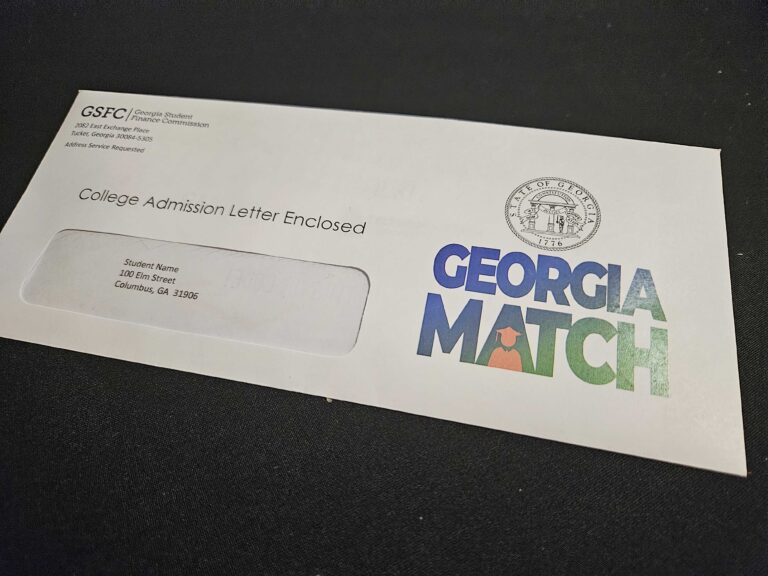
(GA Recorder) — State officials are hoping to make applying to college in Georgia a little easier this month with the rollout of a new program called Georgia Match.
Instead of students applying to colleges, the Georgia Student Finance Commission will reach out to students to offer spots in some of the state’s colleges and technical schools. Gov. Brian Kemp announced the plan Thursday at a workforce summit in downtown Atlanta.
For families of Georgia high school seniors, the process will begin with a letter the governor’s office really hopes they don’t throw away as junk mail.
It will have a big blue and green Georgia Match logo on the front and a return address from the Georgia Student Finance Commission. The bulk of the approximately 120,000 letters are set to be mailed out Oct. 10.
Inside it will be a list of University System of Georgia and Technical College System of Georgia colleges that the student is qualified to attend based on their HOPE GPA.
Students can scan a QR code to connect with the schools, get information on enrollment and financial aid or claim a provisional spot subject to the completion of their required high school classes. Students can still apply for any college even if they do not match.
The University of Georgia, Georgia Tech, and Georgia College and State University will not appear on any of the letters. Those schools use an application process that considers multiple different factors, so students hoping to become a bulldog, yellow jacket, or bobcat will need to apply directly to those schools.
The letter will encourage students to apply in November when all USG and TCSG schools will waive their application fees.
Georgia Student Finance Commission President Lynne Riley said the goal is to show students who do not think college is an option for them that a degree is reachable.

“We want every Georgia high school student to know that there is a place for them to be able to enroll in higher education,” she said. “And the Student Finance Commission has all kinds of scholarships, grants and other awards to help it be the most affordable completion of their higher education goals.”
According to the commission, 38.3% of the Georgia class of 2021 were enrolled in in-state public schools a year after graduation, but another 26.5% were working, 10.6% were out of state, and another 12% were marked unknown. Commission leaders are hoping to steer some members of those groups into state colleges and universities.
Doing so could help them earn, on average, $1 million more over a lifetime than they would with just a high school diploma, according to the commission, but it could also serve to boost the university system’s dwindling enrollment numbers.
Enrollment dropped at USG institutions statewide by .6%, or about 2,800 people in the spring 2023 semester over the previous year, though not every school saw fewer students. Three of Georgia’s four research universities, Georgia Tech, University of Georgia and Augusta University, saw their enrollment grow, while Georgia State University’s student population dropped .5%.
State colleges and universities, as well as comprehensive universities, saw some of the largest declines, with the number of students at Clayton State University dropping 11.7%, the biggest proportional decrease of the semester, from 6,042 students to 5,336.
The past few years have brought similar declines, and University System of Georgia Chancellor Sonny Perdue has been sounding the alarm about the empty desks. That’s because Georgia’s formula for university funding uses the total number of student credit hours as a big factor, so fewer students means less money to spend on paychecks and maintenance.
The state’s most recent budget cut $66 million from funding for universities, further perturbing higher ed heads.
“We look forward to having capacity grow at every one of our Georgia institutions,” Riley said.
High school counselors will have access to the information in the students’ letters and are expected to begin to communicate with families of seniors starting on Friday.
Other states have implemented similar programs, including Idaho, where one study indicated the program increased first-time enrollments by 4 to 8% but had “minimal to no” impact on enrollment for Pell Grant-eligible students.
The commission will keep track of how many students click through the Georgia Match URL to get information and enroll and how many of those go on to attend and graduate from Georgia institutions.
According to the commission, the program’s first year will come with a price tag of $1.3 million for infrastructure, marketing, printing, and mailing.
The governor’s office wants Georgia Match to someday be as much a part of young Georgians’ vocabularies as the state’s previous big college programs.
“It’s our hope that Georgia Match will become as recognizable as the HOPE Scholarship and Grant program in Georgia,” said Andrew Isenhour, Director of Communications for Kemp’s office.






